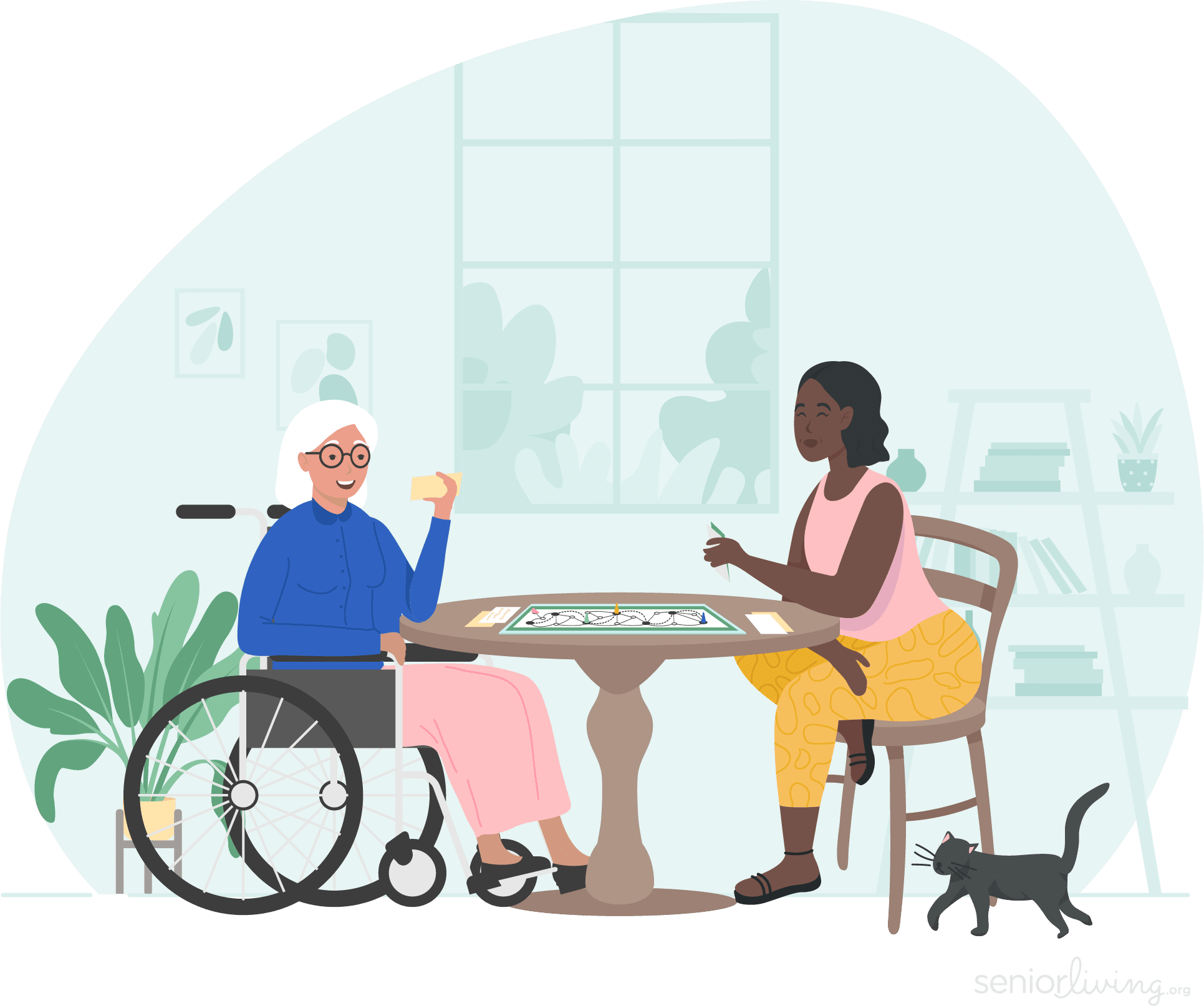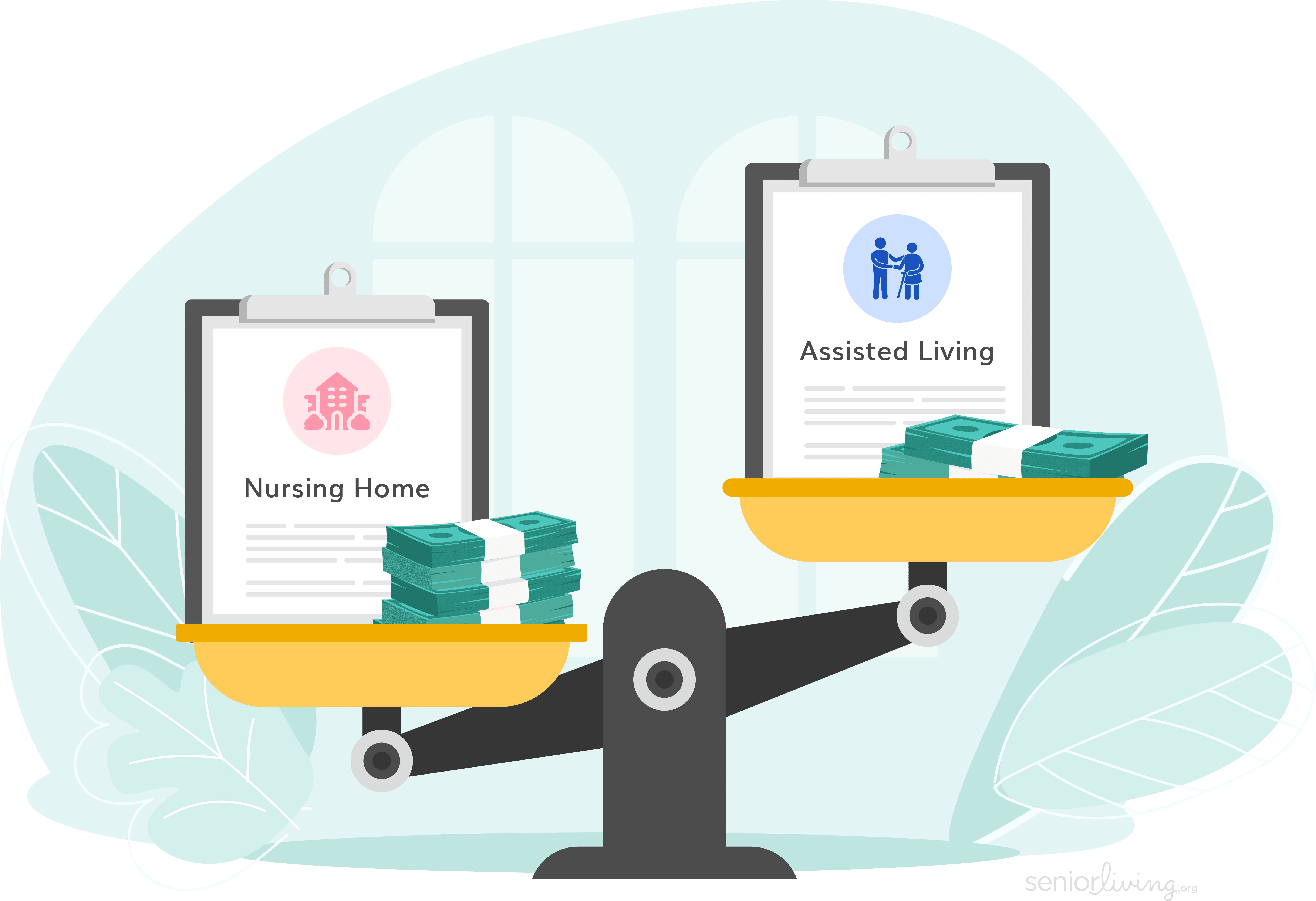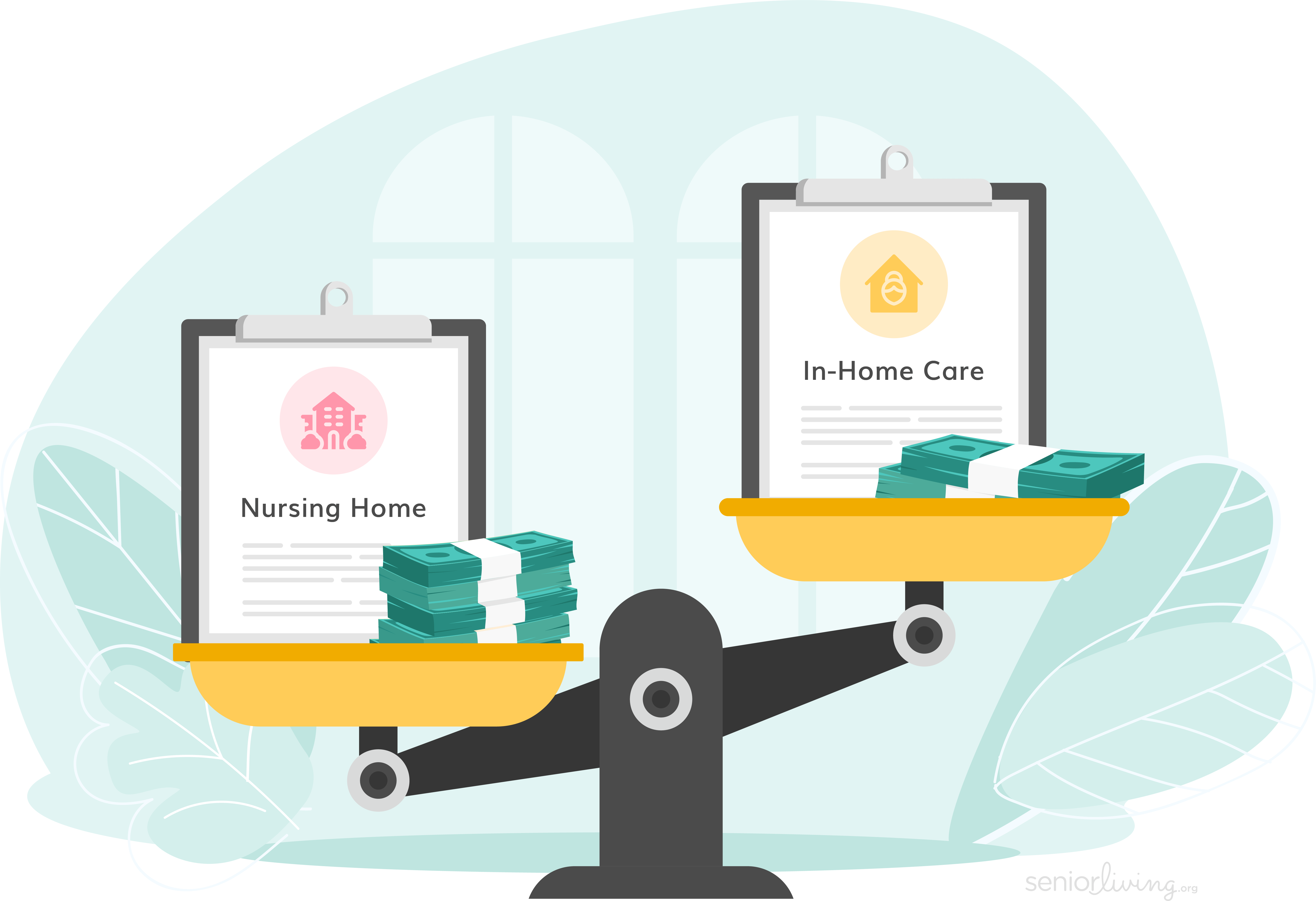Nursing Home Costs in 2025
Nursing home costs vary depending on the state, facility, and level of care required.
SeniorLiving.org is supported by commissions from providers listed on our site. Read our Editorial Guidelines
Find Nursing Homes Near You
Join 51,556 Families Who've Found Nursing Home Communities on SeniorLiving.org.
Or Call: (855) 241-1699Find Nursing Homes Near You
Wondering how much nursing home care costs? That’s a complex question, as several factors can impact the cost of a nursing home stay. These include location, duration of stay, and services required. According to Genworth’s estimates, the median cost of a private room in a nursing home is $339 per day or $10,326 per month in 2025. Semiprivate rooms are more affordable, with a median cost of $302 per day or $9,197 monthly.1 That adds up to an annual cost of $110,360 for a semiprivate room or $123,913 for a private room. Nursing home costs will also vary wildly by location. In 2025, monthly median costs for a semiprivate room range from $5,647 in Texas to $19,845 in Alaska.
Regardless of the cost of nursing care, there are many ways families can make this necessary care more affordable. Let’s explore what you can expect to spend and how most families pay for nursing home care.
Table of Contents
National Median Costs of Nursing Home Care in 2025
The long-term cost of nursing home care will depend on many factors, such as your location, the chosen provider, how long you plan to stay, and whether any special services are needed. In some cases, facilities’ rates are all-inclusive, while others may charge additional fees for certain services, including physical therapy, speech therapy, and memory care.
| Room type | Daily | Monthly | Annually |
|---|---|---|---|
| Semiprivate room | $302 | $9,197 | $110,360 |
| Private room | $339 | $10,326 | $123,913 |
Rates have climbed considerably in recent years, a trend that looks to accelerate over the next several years. If projections hold, the monthly cost of a semiprivate room in a nursing home will be over $10,500 by 2030, an increase of about one-third. For private rooms, expected annual costs already have passed the six-figure mark. Here’s a look at the past, present, and projected annual costs side by side:
| Room type | 2016 | 2024 | 2030 |
|---|---|---|---|
| Semiprivate room | $82,128 | $107,146 | $127,938 |
| Private room | $92,376 | $120,304 | $143,649 |
Nursing Home Costs By State
The state you receive care impacts nursing home costs just as much as the room type; it is much more affordable in some states than others. Here’s a look at the estimated median monthly costs for nursing home care in semiprivate and private rooms, countrywide.
| State | Semiprivate cost per month | Private cost per month |
|---|---|---|
| Alabama | $8,067 | $8,551 |
| Alaska | $19,845 | $36,690 |
| Arizona | $8,067 | $10,003 |
| Arkansas | $7,422 | $8,390 |
| California | $12,101 | $14,037 |
| Colorado | $10,052 | $11,068 |
| Connecticut | $15,973 | $17,587 |
| Delaware | $11,811 | $12,617 |
| District of Columbia | $13,392 | $14,522 |
| Florida | $10,487 | $12,101 |
| Georgia | $8,422 | $8,874 |
| Hawaii | $12,908 | $12,940 |
| Idaho | $11,133 | $11,746 |
| Illinois | $7,906 | $9,197 |
| Indiana | $8,358 | $10,294 |
| Iowa | $8,874 | $9,519 |
| Kansas | $7,939 | $8,487 |
| Kentucky | $8,244 | $9,455 |
| Louisiana | $7,326 | $7,939 |
| Maine | $12,940 | $13,956 |
| Maryland | $12,214 | $13,618 |
| Massachusetts | $14,522 | $15,489 |
| Michigan | $11,214 | $12,165 |
| Minnesota | $10,907 | $13,585 |
| Mississippi | $8,773 | $9,293 |
| Missouri | $6,109 | $6,938 |
| Montana | $8,427 | $8,971 |
| Nebraska | $7,832 | $8,584 |
| Nevada | $10,511 | $13,150 |
| New Hampshire | $11,965 | $13,714 |
| New Jersey | $12,327 | $13,472 |
| New Mexico | $9,293 | $10,616 |
| New York | $14,827 | $15,715 |
| North Carolina | $8,874 | $9,681 |
| North Dakota | $8,390 | $9,116 |
| Ohio | $8,874 | $10,100 |
| Oklahoma | $6,292 | $7,261 |
| Oregon | $15,473 | $16,134 |
| Pennsylvania | $11,424 | $12,262 |
| Rhode Island | $12,908 | $14,359 |
| South Carolina | $9,197 | $9,939 |
| South Dakota | $9,100 | $9,455 |
| Tennessee | $9,181 | $9,842 |
| Texas | $5,647 | $7,100 |
| Utah | $8,067 | $10,730 |
| Vermont | $14,037 | $15,005 |
| Virginia | $9,810 | $10,811 |
| Washington | $12,908 | $14,522 |
| West Virginia | $12,327 | $12,682 |
| Wisconsin | $10,874 | $10,811 |
| Wyoming | $8,067 | $10,003 |
In every state, the cost of both types of rooms in nursing homes rose between 2015 and 2021, and for some states, the increases have been dramatic. Minnesota, which already had a median cost higher than the national average, also saw the most dramatic increase for semiprivate and private rooms. Genworth examines each state’s compound annual growth rate from 2015 to 2021 for the cost of semiprivate and private rooms in nursing homes. In other words, this is an estimate of how much each state’s nursing home prices were rising each year for that period2:
| State | Semiprivate | Private |
|---|---|---|
| Alabama | 2% | 2% |
| Alaska | 5% | 5% |
| Arizona | 1% | 1% |
| Arkansas | 4% | 3% |
| California | 5% | 5% |
| Colorado | 4% | 4% |
| Connecticut | 2% | 3% |
| Delaware | 5% | 5% |
| District of Columbia | 1% | -2% |
| Florida | 3% | 3% |
| Georgia | 4% | 4% |
| Hawaii | 3% | 4% |
| Idaho | 4% | 4% |
| Illinois | 2% | 3% |
| Indiana | 3% | 3% |
| Iowa | 4% | 4% |
| Kansas | 4% | 4% |
| Kentucky | 3% | 3% |
| Louisiana | 3% | 3% |
| Maine | 5% | 5% |
| Maryland | 4% | 5% |
| Massachusetts | 2% | 2% |
| Michigan | 4% | 4% |
| Minnesota | 10% | 10% |
| Mississippi | 2% | 2% |
| Missouri | 2% | 2% |
| Montana | 3% | 3% |
| Nebraska | 6% | 5% |
| Nevada | 3% | 3% |
| New Hampshire | 2% | 3% |
| New Jersey | 3% | 2% |
| New Mexico | 3% | 3% |
| New York | 3% | 3% |
| North Carolina | 3% | 2% |
| North Dakota | 2% | 3% |
| Ohio | 3% | 2% |
| Oklahoma | 4% | 4% |
| Oregon | 4% | 4% |
| Pennsylvania | 3% | 3% |
| Rhode Island | 3% | 1% |
| South Carolina | 4% | 4% |
| South Dakota | 3% | 3% |
| Tennessee | 4% | 4% |
| Texas | 3% | 4% |
| Utah | 5% | 7% |
| Vermont | 4% | 5% |
| Virginia | 4% | 4% |
| Washington | 3% | 3% |
| West Virginia | 7% | 7% |
| Wisconsin | 3% | 3% |
| Wyoming | 1% | 1% |
Watch the video below with Jeff Hoyt, our editor-in-chief, for more information on the cost of nursing homes.

What Is a Nursing Home?
Before discussing the costs of nursing homes, let's first answer the question: What is a nursing home? Nursing homes provide nursing care for seniors around the clock, with 24-hour medical care available. This type of care is also called skilled-nursing care and convalescent care. While seniors typically transition into a nursing home permanently, some homes also provide short stays for those requiring rehabilitation after an injury, illness, or surgery that may require skilled nurses and/or therapists.
FYI: Not all nursing homes are created equal. Use our senior living amenities checklist to find the exact benefits you need.
Whether you need these services part- or full-time, nursing home care comes at a premium price compared to other health care options. However, it also provides older adults with all the valuable services they need concerning medical care, socialization, rehabilitation, and housekeeping services in environments designed to offer the comforts of home.
You can watch our video below to learn more.

Cost of Nursing Homes vs. Assisted Living
Assisted living costs continue to rise, though these communities are much more affordable than nursing homes, as they provide less intensive care. The estimated median cost of assisted living facilities is $187 per day, equating to $5,676 per month or $68,110 per year–depending on your home state. While this represents an increase over the past few years, assisted living is far more affordable than semiprivate or private rooms in nursing homes. It’s important to note that these figures don’t account for specialized care, such as memory care, or consider disabilities.
Our free housing and care finder uses your unique needs to curate a list of the best options in your area.
Cost of Nursing Homes vs. In-Home Care
Options for in-home care providers include homemaking service providers, which can help older people with activities of daily living and household tasks like cleaning, cooking, and running errands. Home health aides are another option since they are trained to provide more extensive care while also serving as companions.
Sometimes, individuals and families may choose skilled in-home nursing care, typically provided by a registered nurse or certified therapist who can administer medication and monitor their vitals regularly. However, the more intense the medical care required, the more expensive it will be. For example, typical homemaker companion services cost about $195 per day, home health aides cost $220 per day, and for a 10-hour workday, a typical registered nurse would make around $400. Though, in most cases, these services aren’t needed all day or daily.

SeniorLiving.org is supported by commissions from providers listed on our site. Read our Editorial Guidelines
Are Nursing Home Costs Tax Deductible?
In most cases, out-of-pocket nursing home costs are tax deductible under itemized medical expenses. If you, your parent, spouse, or another legitimate dependent is in nursing care primarily for medical care, expenses related to medical care, lodging, and meals are deductible. However, seniors in nursing homes for personal reasons (rather than medical) will only be allowed to deduct costs associated with actual medical care, not including meals and boarding costs. Visit our guide to health care tax deductions to learn more about ways to deduct medical expenses.
How to Pay for Nursing Home Costs
Nursing care expenses can be paid for privately. However, you can also fund your care in other ways, including through health insurance, life insurance, long-term insurance policies, savings, reverse mortgages, and local or regional agency assistance.
Payment options
Medicare Coverage for Nursing Home Costs
Medicare will only cover skilled nursing care expenses in specific situations and shouldn’t be used to pay for nursing home or custodial care costs in the long term. One such situation is when a senior has been hospitalized and released but still requires some specialized care. Medicare will help pay for short-term stays in nursing homes if they:
- Were admitted to the hospital for a minimum of three days as an inpatient.
- Have been admitted to a Medicare-certified facility within 30 days of the hospital stay.
- Need skilled care like physical therapy, speech therapy, and other types of rehabilitation.
Those who meet these conditions under original Medicare will qualify for assistance as follows.
- Up to 20 days of nursing care is 100 percent by Medicare.
- After day 21 and up to day 100, patients will pay a copay of up to $200 per day.
- After 100 days, all Medicare coverage ends, and all payments are the patient’s responsibility.
Medicaid Coverage for Nursing Home Care
Medicaid coverage assists beneficiaries with many types of medical care, including doctor’s visits, hospital stays, and long-term care services such as those received in a skilled nursing facility. Often, this program covers 100 percent of these costs, but there may be copayments for select beneficiaries. For those who qualify for Medicaid, this is the best choice for nursing care coverage.
Veterans Benefits for Skilled Nursing Care
Veterans with service-related injuries and disabilities can receive full coverage from the Department of Veterans Affairs for long-term care services at specified locations or through certain providers approved by the department. Long-term VA care includes 24/7 nursing care, physical therapy, help with daily tasks, comfort care, and pain management. Those without service-related disabilities may also qualify for VA benefits if they meet qualifications. However, copayments may be required, depending on the veteran’s status. Visit our guide to Veteran senior care to learn more about the various types of senior housing.
Private Pay
It’s common to pay for nursing home care privately, then move to Medicare or another funding source later. The main benefit of privately paying is flexibility. With Medicare and other taxpayer-subsidized programs, seniors have fewer choices because nursing homes can limit the number of publicly-funded enrollees. So, you need to know the accepted payment setups before moving into a given facility. Sources of private funds could be savings or money from cashing out IRAs and other investments. People borrow from life insurance policies, sell their homes, and get reverse mortgages.
Pro Tip: Are you trying to get your finances to afford nursing care? Read our guide to finances for seniors for all our tips and expert advice on making the most of your money.
Annuity (Savings)
When planning long-term care, someone with savings can buy an annuity. The underwriter receives a lump sum of cash and then issues regular monthly payments to the individual after retirement. The individual can use these payments for a nursing home, a car payment, or anything else. The main advantage of having an annuity is financial discipline. The annuity forces savings to be stretched out over time. Regular payments are guaranteed. Additional advantages of annuities are listed below.
- Savings put into an annuity are shielded from consideration on applications for government aid.
- A person who lives a long life could draw more from the account than they put into it.
The main disadvantage of annuities is that value is lost in commission and annual charges. Also, penalties are charged if funds are withdrawn early.
>>Read More: Annuity Calculator
Life Insurance
A whole life insurance policy (but not a term life insurance policy) can be tapped for long-term care payments. However, this, of course, reduces the financial benefit for heirs. Three approaches are:
- Surrendering a policy
- Selling a policy
- Converting life insurance to “life assurance”
First, a whole life insurance policy can bebe surrendered to the provider. That means the agency purchases the policy back from the policyholder. However, usually, they'll pay just 50 to 75 percent of the face value. If you’re looking for affordable life insurance plans, check out our guide for the best cheap life insurance in 2025.
Similar terms are offered for the second approach: selling the policy to a “life settlements” company. Again, the typical offer is about 50 to 75 percent of the policy's value. The life settlements company pays the policy's premiums until the policyholder passes. The company then receives the financial payout. Life insurance conversion to “life assurance” is a third option designed to pay for long-term senior care. Like life insurance, life assurance includes a savings guarantee (plus an investment portfolio). Life insurance conversion accounts might give less for senior care but preserve a death benefit (inheritance). The advantages and disadvantages vary from person to person. Meeting with a financial advisor could be worthwhile.
>>Learn More: Life Insurance Calculator
Long-Term Care Insurance
Buying long-term care insurance can be smart when someone’s planning to pay for senior care. It offers more freedom of choice than using Medicare and other public programs for nursing home payments. People buy policies that pay anywhere from $2,000 to $10,000 per month. Inflation protection can be included with monthly premium payments to guard against dramatic market changes. It’s important to know that long-term care insurance policies vary regarding when they’ll pay benefits. Generally, to receive payments for nursing home care or assisted living, a person must need help in at least two activities of daily living. A doctor’s statement documenting this need is required as part of the claim. Visit our list of the best long-term care insurance plans to learn more.
Did You Know? One way to lower nursing home costs is to age in place with a medical alert system. Check out our best medical alert system guide to help you make an informed decision.
>>Read About: Long Term Care Calculator
Renting Out a Property
When a senior leaves their old home after moving to a nursing home, renting it out with careful management could be a valuable income source. Turning a home into a rental might become a permanent source of income for the family or a temporary source of income until they sell the house. Ideally, any rental arrangement should be made when the homeowner is still a competent decision-maker. For a loved one to take over, that person will need legal guardianship or power of attorney over the homeowner.
Bridge Loan
Bridge loans can cover people's living expenses as they await a property sale, pension payout, or another virtually guaranteed source of income. A bridge loan is a short-term loan, but often, the first payment isn't due until 90 days after signing. Typical loan lengths vary from three months to two years.
Reverse Mortgage Loan
While a bridge loan can help during a pending home sale, a reverse mortgage loan helps keep the home until the second spouse moves out or passes away. The loaned money can help pay for nursing home care. The advantage of using a reverse mortgage loan for nursing home payments is that it covers two housing costs simultaneously. Loan payments become due when the second person no longer lives in the home. Heirs often opt to sell the property rather than maintain payments.
FYI: One of the best ways to manage your budget is to use an app. Check out these 5 best budgeting apps for seniors.
How Can I Find Nursing Homes Near Me?
You can easily explore nursing homes and skilled care providers with our comprehensive nursing home directory. Our database allows you to search by ZIP code or state, then lets you narrow down your search by specific needs or preferences.
Genworth. (2025). Cost of Care Survey.
Genworth. (2024). Cost of Care Survey: Median Cost Data Tables.




